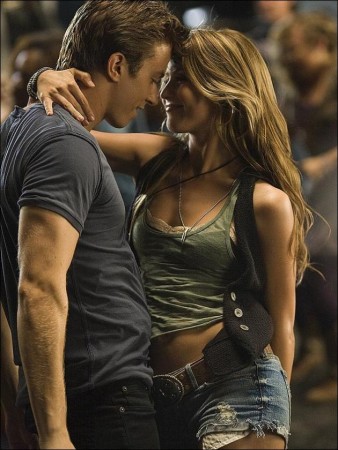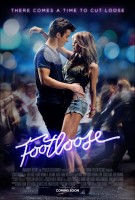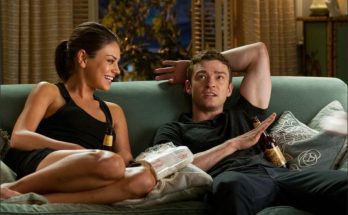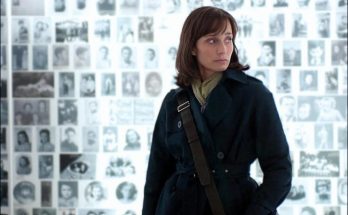Taglines: There comes a time to cut loose.
Writer / Director Craig Brewer (Hustle and Flow, Black Snake Moan) delivers a new take of the beloved 1984 classic film, Footloose. Ren MacCormack (played by newcomer Kenny Wormald) is transplanted from Boston to the small southern town of Bomont where he experiences a heavy dose of culture shock.
A few years prior, the community was rocked by a tragic accident that killed five teenagers after a night out and Bomont’s local councilmen and the beloved Reverend Shaw Moore (Dennis Quaid) responded by implementing ordinances that prohibit loud music and dancing. Not one to bow to the status quo, Ren challenges the ban, revitalizing the town and falling in love with the minister’s troubled daughter Ariel (Julianne Hough) in the process.
Reviving A Classic: A Director’s Passion
Craig Brewer is known for his distinct aesthetic and vision as seen in his critically-acclaimed films “Hustle & Flow” and “Black Snake Moan.” With a reputation of being a filmmaker who infuses his work with realism, grit and passion, Brewer isn’t afraid to shed light on cultural nuances that are deemed taboo by some. Though not a seemingly obvious choice for a mainstream ‘80s classic, Brewer loved the idea of revisiting a film that had a significant impact on his own life.
“When I was 13, “Footloose” had a profound effect on me and completely rocked my dome,” explains Brewer. “The film had teen rebellion couched in community and a religious storyline that didn’t hit you over the head. I felt that it was truly a story that could be told today and still be relevant, entertaining and essentially still “Footloose,” says Brewer.
Craig Zadan, who was also a producer of the original movie, recognized the significance of the film in current times and also believed that it was something that would still resonate with audiences. “There’s a generation now that would find a whole new meaning in this story,” says Zadan. “The film touches on so many issues that people are dealing with today and, in tandem with the musical elements and the classic nature of the story, it feels very contemporary.”
Brewer and Zadan’s shared sensibility about the film’s timelessness made for a perfect match. “There are many people who could have done a rehash of “Footloose,” but it wouldn’t have been unique, original or fresh. There are many directors out there, but very few filmmakers and Craig Brewer is a true filmmaker.”
Brewer’s vision included telling more of Bomont’s back story, which was a town shaken to the core after losing five of their brightest teens, including Reverend Shaw’s own son. “When Craig and I sat down and talked about the movie, we both knew we wanted to shed some light on the point of view of the parents, since we are both parents of young children,” recalls producer Brad Weston. “We didn’t want it to be just a teen rebellion movie because it’s dealing with loss and the lengths that these parents went to, to try and protect their children.”
To bring audiences inside the emotional state of mind of the community, Craig Brewer begins the film with the tragic car accident. “The decision to start with the car crash gives the audience a sense of the pain that led to the extreme restrictions,” states Zadan. “It’s easier to see, in a compassionate way, that this community was filled with grief-ridden parents trying to protect their children and not just a bunch of conservative religious fanatics.”
Location, Production and Costume Design
To honor those die-hard fans of the original film, Craig Brewer peppered the script and visuals in the film with nods to the original. The first thing on Brewer’s list was the iconic canary yellow VW Bug. “The Bug is a sign post to the fans to let them know that while the film is an update, it’s still the “Footloose” that they know and love,” he says.
When it came to creating the look of each of the characters, Costume Designer Laura Jean Shannon’s objective was to find the perfect balance in creating a current look for each character without veering too far away from their original’s signifying looks. “Our challenge was two-fold for this project,” explains Shannon. “We did want to have moments that were nostalgic for the audience, but we also wanted to create our own movie as well. This is very much a love letter to the original and kept that in mind while we were making it.”
Many discussions were had on Ren’s “look” in the film and taking into consideration his urban roots, but Brewer didn’t want to stray from the essence of who Ren is, which is someone who isn’t one to follow trends.
“When I was coming up with the concepts for Ren MacCormack, I wanted to incorporate Kenny’s swagger and the way that he carries himself,” says Shannon. “I thought of James Dean in “Rebel without a Cause”.” I wanted him to be very accessible, but have that rock star vibe.”
An example of how Ren McCormick used his style to make a social statement was his choice of the much-ridiculed skinny tie on his first day at Bomont High. “Ren knew what he was doing when he wore the tie on the first day of school,” argues Brewer. “He knew he was going to be ridiculed for it, but I think there’s a part of him that wanted that.”
The most prominent and memorable throwback to the original for Ariel’s look is the iconic red leather boots. “When I saw the original as a teenager, my friends and I all desperately wanted a pair of red leather cowboy boots, so there’s no way we weren’t going to have them,” says Shannon.
The other piece that remained virtually unaltered in this version is Ariel’s signature prom dress. The peach chiffon dress was a dramatically softer look for the rebellious girl that perfectly complimented the arc of her character. “Ariel has a huge arc in the film and it was important to me to reflect that in the clothes,” explains Shannon.
The Choreography of Footloose
Considered one of the first movies to incorporate equal parts dance and music in a non-traditional way, while maintaining a strong stand-alone dramatic storyline, it was hugely important to the filmmakers that this film be as powerful and organic. Original producers Craig Zadan and Neil Meron had worked with choreographer Jamal Sims on the film adaptation of “Hairspray” and knew he would be a perfect choice to update the dance elements of “Footloose” for a new generation.
Sims, whose extensive credits include the “Step Up” franchise, Madonna’s Sticky and Sweet tour, the 82nd Annual Academy Award® and several appearances on So You Think You Can Dance, jumped at the opportunity to work on a project that made an impact on himself as a dancer. “The original “Footloose” was the first time I’d seen that kind of raw street dancing on the big screen and it made me want to dance,” recalls Sims. “I absolutely had to work on this movie.” “When Jamal and I first met, our common concern was how to have amazing choreography without it looking overly choreographed,” says Brewer.
A significant obstacle was upping the quality of the dancing and choreography to satisfy the sophisticated appetites of audiences without straying from the freestyle and organic nature of how the dancing services the story. “We had to always be aware of dialing it up and down because audiences are much more dance savvy and expect more because they’ve seen so much amazing dancing on television and in films,” says Sims.
Due to the facts that both leads are professional dancers, the filmmakers had the advantage of not needing an extensive rehearsal schedule. A few weeks prior to shooting, Sims worked with the leads and the background dancers separately and then brought the two groups together the weekend before shooting to work out the blocking and to make final changes. To give the actors the opportunity to focus on their dramatic performances before diving into the dance, the shooting schedule was structured so that all the dance numbers were at the end of the schedule. By the time the actors finally got to the dance sequences, after putting their all into the dramatic scenes and storyline, there was a great sense of elation and excitement.
“When we finally got to the dance number it was like ‘Whoo! We can finally dance and have fun!’ We felt like we were literally the kids of Bomont, we hadn’t danced for so long and were so grateful to do something light and fun and get it out,” recalls Hough.
In the film, Ren gets his first taste of the local culture when he is taken to the drive-in theater where the kids of Bomont gather to hang out. The drive-in is a safe haven where the kids play music and cut loose, away from adult supervision and local law enforcement. To reflect the spontaneous and rebellious nature of the gathering, the movement is less about structure and synchronicity and more about subculture and freestyle.
For Wormald, whose dance style leans more toward street dancing, the drive-in gave him the opportunity to be in his comfort zone and freestyle without the confines of hitting every beat. “We didn’t overwork the drive-in and wanted it to feel organic. If the cops or any adults came by we could break it up quickly, so it was just a free moving and fun hip-hop type of thing,” explains Wormald.
For Julianne Hough, whose ballroom and Latin dancing borders on being a national treasure, the drive-in dance sequence was out of her comfort zone and proved to be the most challenging. “When we first started working on the drive-in choreography with all the booty-shaking and popping, I couldn’t stop laughing. I wasn’t sure I could do it without looking totally uncomfortable, but Jamal was fantastic and helped make it incredibly fun for me.”
In the film, Ren, Ariel, Willard and Rusty also venture to Bomont’s county line to a Cowboys bar to blow off a little steam and do some ‘research’ for their fight to lift the dance ban. “While the drive-in was more of Kenny’s number, I felt like the Cowboys was mine and was my chance to shake my booty the way I know how to do it. I didn’t have to tone down the whipping of my hair, or ‘hairography’ as Craig Brewer calls it, and Cowboys gave me the chance to let it all go and have fun like a teenager.”
Although the dance style is country line dancing, which is not traditionally known for its heat index, Brewer’s objective was to amp it up and put a new spin on it. “Our version of country line dancing is pretty hot and energetic. It ain’t your Grandpa’s line dancing, that’s for sure,” laughs Brewer.
Reeling from the pressure and blowback from the community, Ren drives to a warehouse to purge his frustration and be alone. Just a man and his music. Brewer set out to capture the raw emotion of the moment and get inside the power of expression and movement. “For Jamal, Kenny and I, we look at the angry dance as the pinnacle of our existence. We knew we needed to nail it and it’s the perfect storm of all of our abilities.”
One of the most recognized and celebrated dance pieces ever filmed, the “Angry Dance” (as it is commonly known) was an enormous priority for Brewer and a major impetus to do the film. “Every filmmaker has a reason why they are doing a movie. I have a few for “Footloose,” but if I were to pick just one, it would absolutely be the angry dance,” says Brewer. Drawing inspiration from the locale of the story and Brewer’s own southern roots, the piece is more rock and blues leaning with a grittier and more emotionally raw feel to it. “Our angry dance is dangerous and there’s a sense of peril to it,” says Brewer. “Ren cuts himself and is covered in dust. This kind of dance isn’t about being pretty, it’s raw and it hurts.”
For the filmmakers and cast, shooting the dance finale piece was a pinch yourself type of moment. “I put on the red jacket, the song came on and, in that moment, I fully realized that we were really making “Footloose.” The reality of what we were doing really sunk in,” recalls Wormald.
The magnitude of dancing to the Kenny Loggins music doing original choreography wasn’t lost on Hough either. “We were at the rehearsal for the final dance and, at one point, both Kenny and I were standing on stools watching all the dancers prior to be slotted in, and it completely overwhelmed me. I got teary-eyed and I looked over at Kenny and saw tears in his eyes too. The magnitude of what we were doing hit us together and it was truly exhilarating.”
Footloose
Directed by: Craig Brewer
Starring: Kenny Wormald, Julianne Hough, Dennis Quaid, Miles Teller, Andie MacDowell, Kim Dickens, Ziah Colon, Maggie Elizabeth Jones, Mary-Charles Jones, Enisha Brewster
Screenplay by: Dean Pitchford, Craig Brewer
Production Design by: Jon Gary Steele
Cinematography by: Amy Vincent
Film Editing by: Billy Fox
Costume Design by: Laura Jean Shannon
Set Decoration by: Dena Roth
Art Direction by: Chris Cornwell
Music by: Deborah Lurie
MPAA Rating: PG-13 for some teen drug and alcohol use, sexual content, violence and language.
Studio: Paramount Pictures
Release Date: October 14, 2011
Hits: 232






